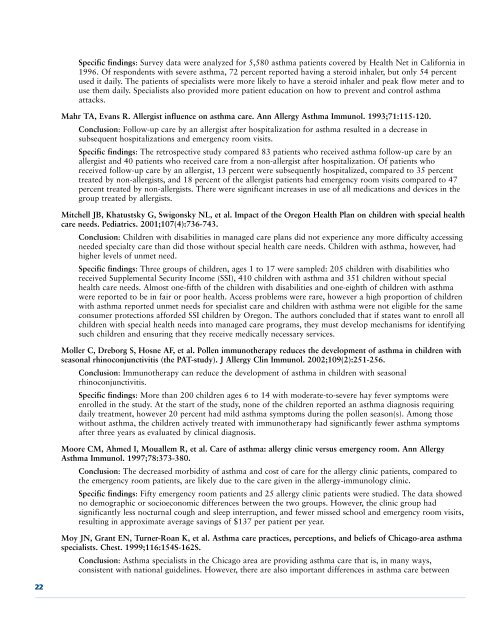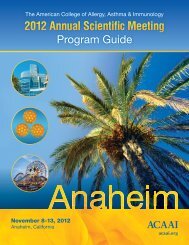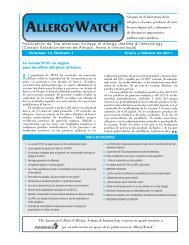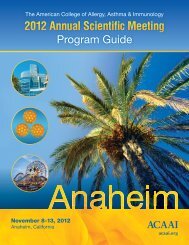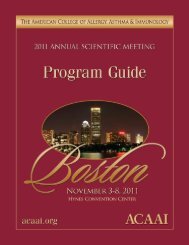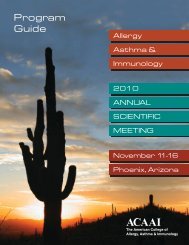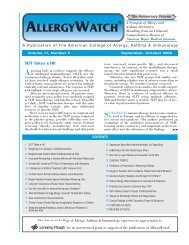Better Outcomes at Lower Cost - American College of Allergy ...
Better Outcomes at Lower Cost - American College of Allergy ...
Better Outcomes at Lower Cost - American College of Allergy ...
- No tags were found...
Create successful ePaper yourself
Turn your PDF publications into a flip-book with our unique Google optimized e-Paper software.
Specific findings: Survey d<strong>at</strong>a were analyzed for 5,580 asthma p<strong>at</strong>ients covered by Health Net in California in1996. Of respondents with severe asthma, 72 percent reported having a steroid inhaler, but only 54 percentused it daily. The p<strong>at</strong>ients <strong>of</strong> specialists were more likely to have a steroid inhaler and peak flow meter and touse them daily. Specialists also provided more p<strong>at</strong>ient educ<strong>at</strong>ion on how to prevent and control asthma<strong>at</strong>tacks.Mahr TA, Evans R. Allergist influence on asthma care. Ann <strong>Allergy</strong> Asthma Immunol. 1993;71:115-120.Conclusion: Follow-up care by an allergist after hospitaliz<strong>at</strong>ion for asthma resulted in a decrease insubsequent hospitaliz<strong>at</strong>ions and emergency room visits.Specific findings: The retrospective study compared 83 p<strong>at</strong>ients who received asthma follow-up care by anallergist and 40 p<strong>at</strong>ients who received care from a non-allergist after hospitaliz<strong>at</strong>ion. Of p<strong>at</strong>ients whoreceived follow-up care by an allergist, 13 percent were subsequently hospitalized, compared to 35 percenttre<strong>at</strong>ed by non-allergists, and 18 percent <strong>of</strong> the allergist p<strong>at</strong>ients had emergency room visits compared to 47percent tre<strong>at</strong>ed by non-allergists. There were significant increases in use <strong>of</strong> all medic<strong>at</strong>ions and devices in thegroup tre<strong>at</strong>ed by allergists.Mitchell JB, Kh<strong>at</strong>ustsky G, Swigonsky NL, et al. Impact <strong>of</strong> the Oregon Health Plan on children with special healthcare needs. Pedi<strong>at</strong>rics. 2001;107(4):736-743.Conclusion: Children with disabilities in managed care plans did not experience any more difficulty accessingneeded specialty care than did those without special health care needs. Children with asthma, however, hadhigher levels <strong>of</strong> unmet need.Specific findings: Three groups <strong>of</strong> children, ages 1 to 17 were sampled: 205 children with disabilities whoreceived Supplemental Security Income (SSI), 410 children with asthma and 351 children without specialhealth care needs. Almost one-fifth <strong>of</strong> the children with disabilities and one-eighth <strong>of</strong> children with asthmawere reported to be in fair or poor health. Access problems were rare, however a high proportion <strong>of</strong> childrenwith asthma reported unmet needs for specialist care and children with asthma were not eligible for the sameconsumer protections afforded SSI children by Oregon. The authors concluded th<strong>at</strong> if st<strong>at</strong>es want to enroll allchildren with special health needs into managed care programs, they must develop mechanisms for identifyingsuch children and ensuring th<strong>at</strong> they receive medically necessary services.Moller C, Dreborg S, Hosne AF, et al. Pollen immunotherapy reduces the development <strong>of</strong> asthma in children withseasonal rhinoconjunctivitis (the PAT-study). J <strong>Allergy</strong> Clin Immunol. 2002;109(2):251-256.Conclusion: Immunotherapy can reduce the development <strong>of</strong> asthma in children with seasonalrhinoconjunctivitis.Specific findings: More than 200 children ages 6 to 14 with moder<strong>at</strong>e-to-severe hay fever symptoms wereenrolled in the study. At the start <strong>of</strong> the study, none <strong>of</strong> the children reported an asthma diagnosis requiringdaily tre<strong>at</strong>ment, however 20 percent had mild asthma symptoms during the pollen season(s). Among thosewithout asthma, the children actively tre<strong>at</strong>ed with immunotherapy had significantly fewer asthma symptomsafter three years as evalu<strong>at</strong>ed by clinical diagnosis.Moore CM, Ahmed I, Mouallem R, et al. Care <strong>of</strong> asthma: allergy clinic versus emergency room. Ann <strong>Allergy</strong>Asthma Immunol. 1997;78:373-380.Conclusion: The decreased morbidity <strong>of</strong> asthma and cost <strong>of</strong> care for the allergy clinic p<strong>at</strong>ients, compared tothe emergency room p<strong>at</strong>ients, are likely due to the care given in the allergy-immunology clinic.Specific findings: Fifty emergency room p<strong>at</strong>ients and 25 allergy clinic p<strong>at</strong>ients were studied. The d<strong>at</strong>a showedno demographic or socioeconomic differences between the two groups. However, the clinic group hadsignificantly less nocturnal cough and sleep interruption, and fewer missed school and emergency room visits,resulting in approxim<strong>at</strong>e average savings <strong>of</strong> $137 per p<strong>at</strong>ient per year.Moy JN, Grant EN, Turner-Roan K, et al. Asthma care practices, perceptions, and beliefs <strong>of</strong> Chicago-area asthmaspecialists. Chest. 1999;116:154S-162S.Conclusion: Asthma specialists in the Chicago area are providing asthma care th<strong>at</strong> is, in many ways,consistent with n<strong>at</strong>ional guidelines. However, there are also important differences in asthma care between22


